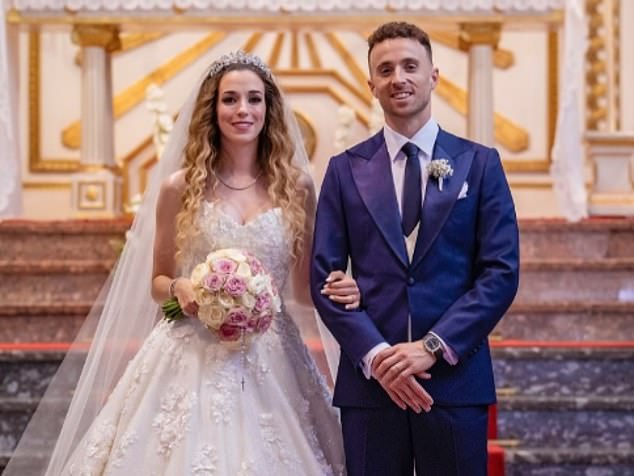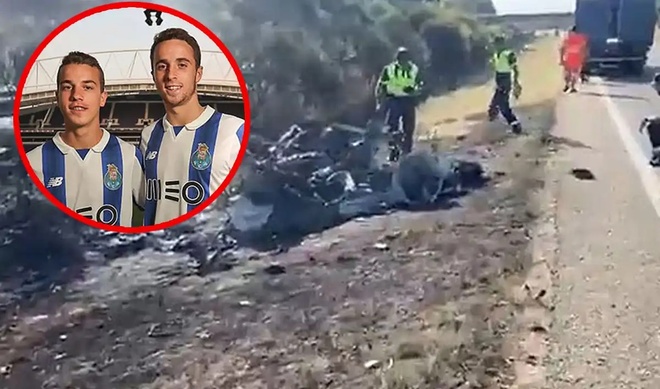On a quiet stretch of the A-52 highway in Zamora, Spain, in the early hours of July 3, 2025, a catastrophic event unfolded that would send shockwaves through the global football community. Diogo Jota, the 28-year-old star forward for Liverpool and the Portuguese national team, along with his younger brother Andre Silva, lost their lives in a horrific car accident. The vehicle, a sleek Lamborghini, was reduced to a mangled, charred wreck after a high-speed mishap that investigators have now attributed to a sudden tire blowout. This tragedy, occurring just weeks after Jota’s fairytale wedding, has left fans, teammates, and the sports world grappling with grief and searching for answers. How did this vibrant athlete, at the peak of his career and personal life, meet such an abrupt and devastating end?
A Star’s Journey Cut Short
Diogo Jota was more than just a footballer; he was a symbol of resilience, talent, and unrelenting drive. Born in Massarelos, Portugal, in 1996, Jota rose through the ranks of Paços de Ferreira’s youth academy, catching the eye of scouts with his explosive pace and clinical finishing. His career trajectory took him to Atlético Madrid, Porto, and Wolverhampton Wanderers before landing him at Liverpool in 2020 for a reported €44.7 million. At Liverpool, he became a fan favorite, known for his work rate, versatility, and knack for scoring crucial goals. With 182 appearances, 65 goals, and 26 assists for the Reds, Jota helped secure a Premier League title, an FA Cup, and a League Cup. On the international stage, he earned 49 caps for Portugal, contributing 14 goals and sharing in the glory of two UEFA Nations League triumphs alongside his idol, Cristiano Ronaldo.
![]()
Off the pitch, Jota’s life was equally inspiring. Just 11 days before the accident, on June 22, 2025, he married his longtime partner, Rute Cardoso, in a joyous ceremony in Porto. The couple, who had three young children—Denis, Duarte, and a newborn daughter—shared moments of their happiness on social media, with Jota describing himself as the “luckiest man alive.” These glimpses into his personal life made the news of his passing all the more heart-wrenching, as fans mourned not only a sporting hero but a devoted husband and father.
The Fateful Night
The accident occurred around 12:30 a.m. on the A-52, a major highway connecting northern Portugal to Spanish ports like Santander and Bilbao. Known for its long, high-speed stretches, the road has a history of serious collisions, and that night proved no exception. Jota, reportedly at the wheel of the Lamborghini, was traveling with his 26-year-old brother Andre, a professional footballer playing for FC Penafiel in Portugal’s second division. The brothers were said to be returning from a trip, possibly savoring a moment of downtime after Jota’s recent wedding and a triumphant season.

According to preliminary investigations, the Lamborghini was moving at a high speed when Jota attempted to overtake another vehicle. In that critical moment, one of the car’s tires suffered a catastrophic failure, likely due to a sudden blowout. The immense speed—combined with the loss of control—sent the supercar careening off the road. The vehicle flipped multiple times, crashing into a roadside barrier before erupting into flames. The fire was so intense that it spread to nearby vegetation, creating a nightmarish scene described by witnesses as resembling a “fireball.” Emergency services, including Zamora’s traffic police, firefighters, and medical teams, rushed to the site, but the inferno left no chance for rescue. The brothers perished at the scene, their identities later confirmed through the vehicle’s license plate, as the wreckage was too severely damaged for immediate recognition.
The Aftermath: A World in Mourning
News of Jota’s death spread rapidly, plunging the football world into a state of collective shock. Liverpool Football Club issued a somber statement, expressing their devastation and requesting privacy for the families of Jota and Andre. The club vowed to provide full support to those affected, reflecting the deep bond Jota had forged with his teammates and staff. Tributes poured in from across the globe, with players, coaches, and fans sharing memories of Jota’s electrifying performances and warm personality. Cristiano Ronaldo, a mentor and teammate on the Portuguese national team, posted an emotional message online, offering condolences to Jota’s wife, children, and loved ones, and urging them to find strength in the face of unimaginable loss.

The tragedy also sparked conversations about road safety, particularly the risks associated with high-performance vehicles like the Lamborghini. While the car’s engineering is designed for speed and precision, even minor defects—such as a tire failure—can prove catastrophic at extreme velocities. The A-52’s reputation as a high-risk road further amplified calls for stricter safety measures, with some advocating for enhanced monitoring or speed restrictions on similar highways.
Unraveling the Cause
Investigators have zeroed in on the tire blowout as the primary cause of the crash, though the exact circumstances remain under scrutiny. High-speed driving, especially during an overtaking maneuver, places immense stress on a vehicle’s tires, and any weakness—whether from wear, damage, or a manufacturing flaw—can lead to disaster. The Lamborghini, a symbol of luxury and performance, was likely equipped with state-of-the-art tires, but no system is infallible. Authorities are examining the vehicle’s maintenance records, the condition of the road, and data from the car’s black box to piece together the sequence of events. While initial reports rule out involvement of other vehicles or external factors like weather, the investigation continues to ensure no stone is left unturned.

The blowout’s impact was exacerbated by the car’s speed, which likely exceeded safe limits for that stretch of road. The sudden loss of traction would have made it nearly impossible for even an experienced driver to regain control, especially in a low-slung supercar designed for agility rather than stability in emergencies. The violent flips and subsequent fire underscore the sheer force of the crash, leaving the Lamborghini unrecognizable—a twisted heap of metal and ash.
A Personal and Professional Legacy
Jota’s death is a stark reminder of life’s fragility, even for those who seem invincible. At 28, he was in the prime of his career, with analysts predicting many more years of dominance. His versatility as a forward, able to play across the front line, made him a cornerstone of Liverpool’s attacking strategy. His tireless pressing and ability to deliver in clutch moments earned him the nickname “warrior” among fans, a testament to his relentless spirit.
Andre Silva, though less known globally, was carving his own path in football. At 26, he was a key player for Penafiel, displaying promise as an attacking midfielder. The brothers shared a close bond, often seen supporting each other’s careers, and their simultaneous loss has compounded the grief for their family and community.
Reflections on a Tragedy
The loss of Diogo Jota and Andre Silva has left an indelible mark on the world of sports and beyond. For fans, it’s a moment to reflect on the human side of athletes—individuals who, despite their fame, face the same vulnerabilities as anyone else. For the football community, it’s a call to honor Jota’s legacy through continued passion and dedication on the pitch. UEFA’s decision to hold a minute’s silence during a women’s international match between Spain and Portugal was a fitting tribute, symbolizing the unity of the sport in times of sorrow.
As investigations proceed, the focus remains on supporting the families left behind, particularly Rute Cardoso and her three children, who now face an uncertain future without their husband and father. The outpouring of love from fans, with candlelit vigils and memorials outside Anfield, speaks to the profound impact Jota had in his short life.
Moving Forward
While the pain of this tragedy will linger, Jota’s memory endures through his achievements, his family, and the countless lives he touched. The football world will rally, as it always does, to celebrate his contributions and ensure his legacy lives on. For now, the focus is on healing, understanding, and preventing such heartbreak in the future. The A-52 highway, forever marked by this loss, serves as a somber reminder to cherish every moment and drive with care, no matter how invincible one feels behind the wheel.

